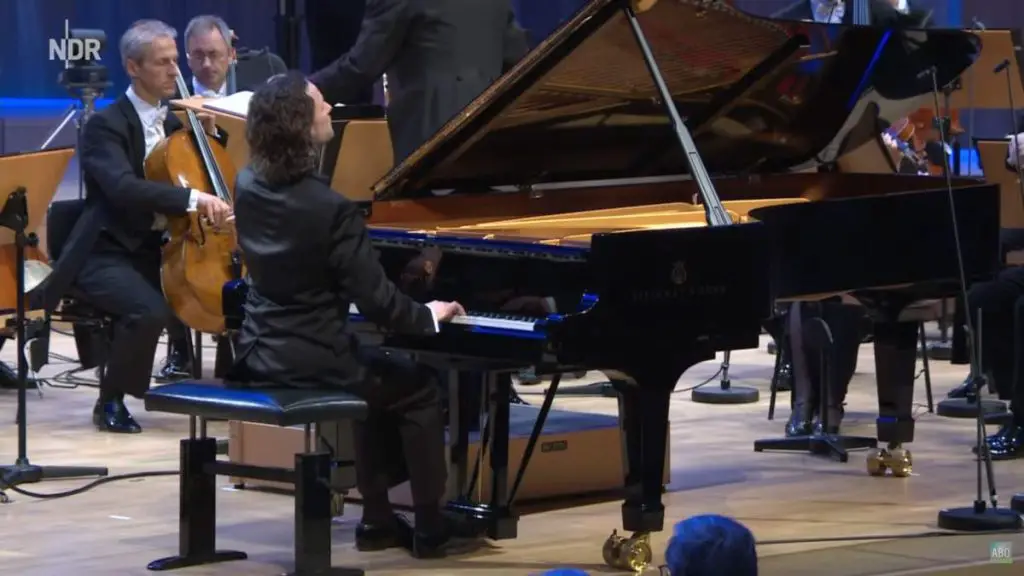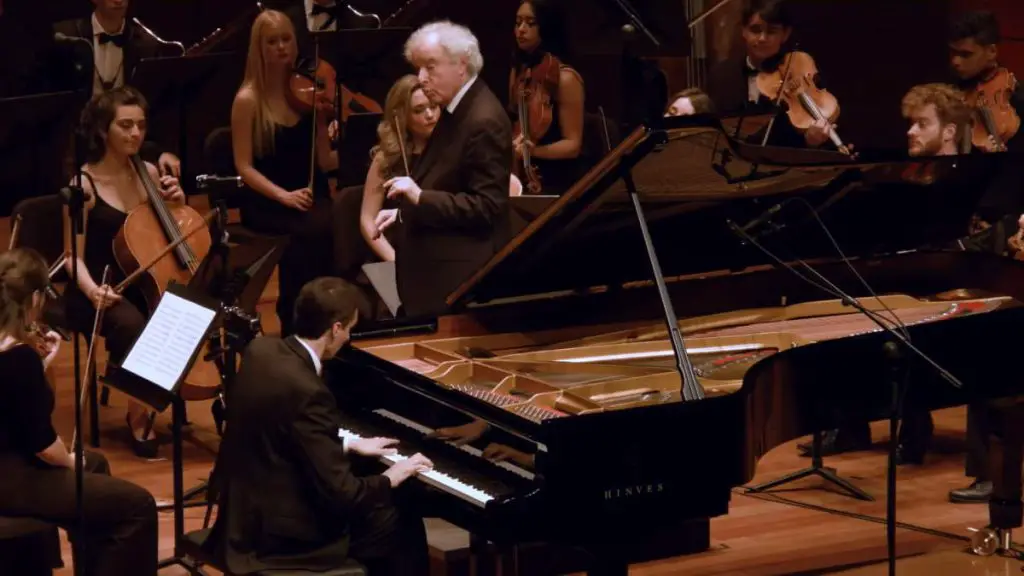Accompanied by the NDR Radiophilharmonie, the German pianist Martin Helmchen performs Wolfgang Amadeus Mozart’s Piano Concerto No. 17 in G major, KV. 453. Conductor: Andrew Manze. Recorded on March 31, 2022, at the Großer Sendesaal of the NDR Landesfunkhaus Niedersachsen Broadcasting Center.
Mozart’s Piano Concerto No. 17
Mozart’s Piano Concerto No. 17 in G major, K. 453, composed in 1784, is one of the series of great piano concertos written in Vienna during the height of his career. This concerto is particularly noted for its lyrical beauty, structural elegance, and the playful interaction between the piano and orchestra.
One of the most charming aspects of this concerto is its melodious and expressive nature, which Mozart achieves through a masterful balance of the solo piano part with the orchestral accompaniment. The piano lines are intricate yet singable, showcasing Mozart’s ability to create melodies that are both sophisticated and instantly appealing. The orchestral parts, meanwhile, are crafted to complement and converse with the piano, rather than merely supporting it. This creates a sense of dialogue throughout the piece, a hallmark of Mozart’s concertos.
The concerto was composed during a period when Mozart was also deeply involved in the creation of operas, and this influence is evident in the concerto’s dramatic qualities and the way the piano and orchestra interact almost like characters in a play. The overall mood of the concerto is cheerful and optimistic, with the music flowing effortlessly from one idea to the next.
An interesting anecdote about this concerto involves Mozart’s pet starling. Reportedly, the bird could sing a theme from the concerto, which Mozart noted in his diary along with a playful comment on the bird’s accuracy. This story, whether fully true or not, adds a personal and whimsical touch to the history of the concerto.
Mozart’s Piano Concerto No. 17 is not just a showcase of his technical skill as a composer and pianist but also a reflection of his deep understanding of musical form and his ability to infuse classical structures with a fresh, lively spirit. Its continued popularity in concert halls today is a testament to its enduring appeal and Mozart’s genius.
Movements
With start times in the video:
- Allegro 00:23
- Andante 12:35
- Allegretto – Presto 23:06
1. Allegro
The first movement of Mozart’s Piano Concerto No. 17 in G major, K. 453, is a brilliant exemplar of his concerto style, characterized by its lyrical melodies, graceful form, and the dynamic interplay between the soloist and orchestra. Following the classical concerto tradition, this movement is set in sonata-allegro form, which typically includes an exposition, development, and recapitulation.
In the exposition, the orchestra introduces the main thematic material. The themes are distinct and memorable, featuring Mozart’s signature blend of elegance and playful charm. After the orchestral introduction, the piano enters, echoing and elaborating on the themes introduced by the orchestra. Mozart’s writing for the piano is both virtuosic and expressive, allowing the soloist to shine while maintaining a harmonious balance with the orchestral parts.
The development section of the movement is where Mozart showcases his skill in varying and elaborating on the themes. Here, the music explores different keys and develops the thematic material, creating a sense of tension and anticipation. This section often features intricate interplay between the piano and the orchestra, with Mozart using the opportunity to display the soloist’s technical prowess and interpretative depth.
The movement concludes with a recapitulation, where the main themes return, this time grounded in the home key. In many of Mozart’s concertos, the recapitulation includes a cadenza, a moment where the soloist plays a virtuosic solo passage, often improvised or pre-composed by the performer. The cadenza serves as a showcase for the pianist’s skill and creativity before the movement ends with a return to the main themes and a final orchestral flourish.
The first movement of this concerto is notable for its blend of lyrical beauty, structural clarity, and the engaging dialogue between the solo piano and the orchestra. It’s a testament to Mozart’s genius in balancing complexity with accessibility, making his music both intellectually satisfying and widely beloved.
2. Andante
The second movement of Mozart’s Piano Concerto No. 17 in G major, K. 453, is a striking contrast to the first, exuding a serene and introspective quality. This movement is often noted for its lyrical beauty and emotional depth.
Typically, in Mozart’s piano concertos, the second movement serves as a lyrical and expressive counterpoint to the more energetic first and third movements. In this concerto, the second movement, marked Andante, is no exception. It unfolds in a song-like manner, showcasing Mozart’s ability to create deeply affecting melodies.
The movement is characterized by a gentle, flowing theme introduced by the piano, which is then taken up and elaborated upon by the orchestra. The dialogue between the piano and orchestra is more subdued and intimate compared to the first movement, creating a sense of contemplation and emotional richness. The orchestration is lighter, allowing the piano’s lyrical lines to shine through, and the overall mood is one of peacefulness and introspection.
Mozart’s use of subtle variations and developments of the main theme throughout this movement adds to its expressive depth. The piano part, while less virtuosic than in the outer movements, requires a high degree of expressiveness and control, as it navigates through the delicate nuances of the melody.
The second movement also often features a central section that provides contrast in mood and texture, sometimes exploring minor keys or more dramatic musical ideas, before returning to the tranquil and lyrical theme of the opening.
3. Allegretto – Presto
The third movement of Mozart’s Piano Concerto No. 17 in G Major, marked Allegretto, brings the concerto to a lively and playful conclusion. This movement is written in the form of a rondo, a structure where the main theme alternates with contrasting episodes. The cheerful main theme, introduced by the piano, is immediately memorable for its lightness and dance-like character. It sets a joyful tone that runs throughout the movement, exuding a sense of brightness and optimism.
As the piano and orchestra engage in lively exchanges, Mozart introduces several contrasting episodes that showcase different moods and colors. These episodes, while varied in tone, maintain the overall spirited energy of the movement. The piano part is full of lively, virtuosic passages, with fast runs and intricate embellishments, offering the soloist moments of technical brilliance. However, Mozart ensures that the virtuosic elements never overshadow the charm and elegance of the music.
The interplay between the piano and orchestra is dynamic, with the two frequently echoing each other’s phrases or engaging in playful back-and-forth exchanges. The movement alternates between moments of light-hearted playfulness and more robust, energetic sections, all tied together by the recurring rondo theme.
In the final section, the music builds toward a joyous and exhilarating conclusion, bringing the concerto to a satisfying close. The Allegretto is filled with wit, charm, and exuberance, leaving the audience with a sense of delight and a reminder of Mozart’s skill in combining technical complexity with lighthearted elegance.
Martin Helmchen
Martin Helmchen was born in Berlin in 1982. He began his piano studies at the age of six and graduated from the Hanns Eisler Music Conservatory as a student of Galina Iwanzowa, and in 2001 from the Hochschule für Musik und Theater Hannover as a student of Arie Vardi.
He was a featured soloist in the BBC New Generation Artists program from 2005 to 2007. Helmchen has given concerts with the San Francisco Symphony, the Vienna Philharmonic, the Deutschen Symphonie-Orchester Berlin, and the NHK Symphony Orchestra.

His specialty is chamber music, where he has performed extensively with Heinrich Schiff and Marie-Elisabeth Hecker. Collaborations with further artists have included Gidon Kremer, Christian Tetzlaff, Sharon Kam, Tabea Zimmermann, Juliane Banse, Julia Fischer, Sabine Meyer, and Lars Vogt.
He made his American debut in 2011 when he played at Tanglewood with the Boston Symphony Orchestra. The same year he performed with Dohnanyi and the Chicago Symphony Orchestra.
In 2001 he won the Clara Haskil International Piano Competition. In 2003 he won the International Kissinger Klavierolymp Competition, related to the festival Kissinger Sommer.
In 2006 he was awarded the Crédit Suisse Award, for his debut with the Vienna Philharmonic, directed by Valery Gergiev, playing Schumann’s Piano Concerto at the Lucerne Festival.
Again, in 2006, he received the ECHO Klassik Prize together with cellist Danjulo Ishizaka for their CD with works from Felix Mendelssohn, César Franck, and Benjamin Britten (2005, Sony Classical).
Sources
- Piano Concerto No. 17 (Mozart) on Wikipedia


![Mozart: Piano Concerto No. 17 [Fortepiano: Kristian Bezuidenhout, Freiburger Barockorchester]](https://cdn-0.andantemoderato.com/wp-content/uploads/2016/09/Mozart-Piano-Concerto-No-17-Fortepiano-Kristian-Bezuidenhout-1024x576.jpg)